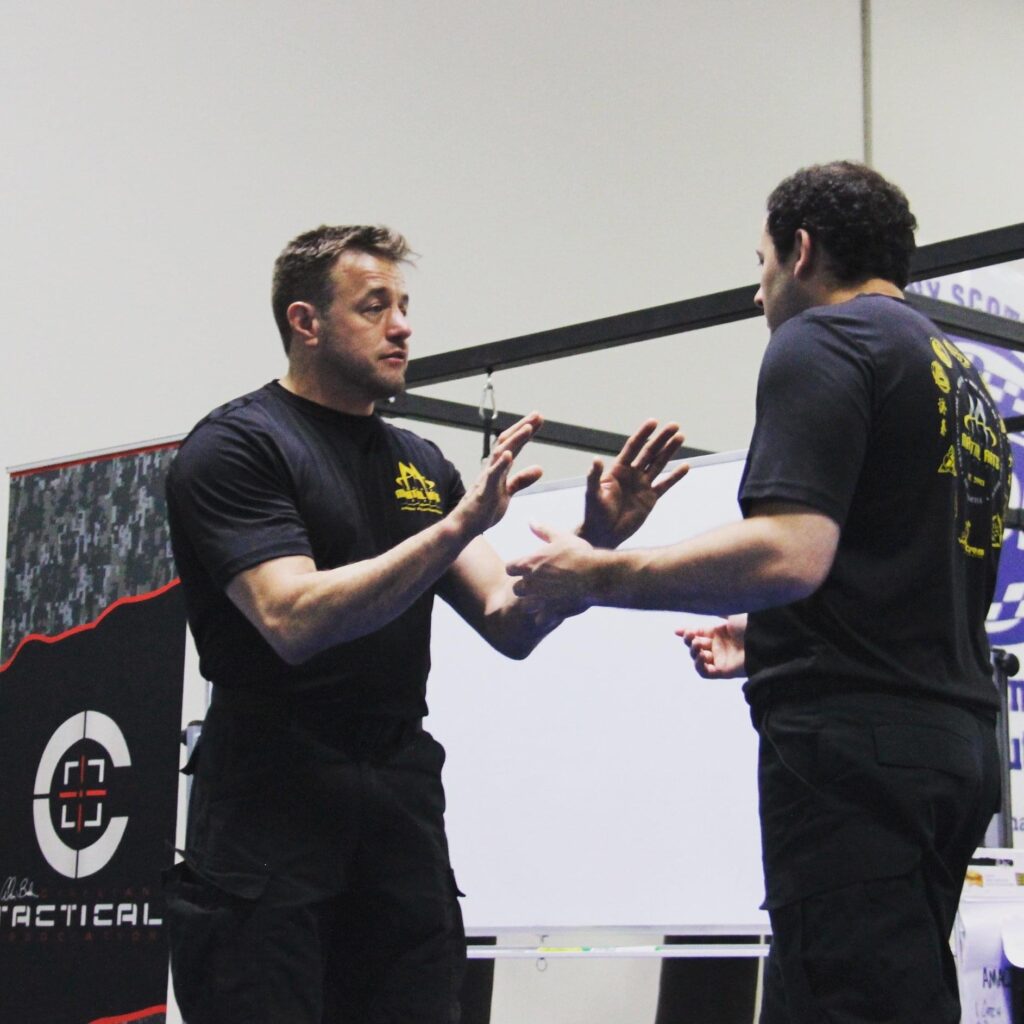
Self-defense encounters often begin in what is known as the social exchange range. This is the distance at which you are generally close enough to engage in conversation, typically just outside or within arm’s reach. The ability to understand and effectively navigate this range, especially leading up to a potentially violent encounter, is crucial. It can mean the difference between finding yourself in a tactically advantageous position or a vulnerable one when an altercation starts.
In the realm of self-defense, positioning is critical. Poor positioning could result in being caught off guard by a sudden, unexpected attack, such as a sucker punch, or worse, finding yourself on the receiving end of a weapon. On the other hand, good positioning can place you ahead of your opponent’s moves, allowing you the crucial time needed to neutralize their attack or launch an effective counterattack.
At the C-Tac, which stands for Civilian Tactical, we refer to this pivotal range as “Critical Distance.” Our study of Critical Distance is not just about recognizing the physical space between you and a potential aggressor but also involves a keen understanding of subtle cues and pre-attack indicators. These indicators can provide advanced warning of an impending attack, which is essential in self-defense.
One of the key aspects of mastering Critical Distance is learning to read the minute shifts in an opponent’s weight. These shifts often precede an advancement or attack, acting as telltale signs of their intentions. Being able to interpret these subtle movements can give you a significant advantage, allowing you to prepare and respond accordingly.

In addition to physical movements, the study of Critical Distance also encompasses the observation of small mannerisms. These can include gestures, facial expressions, or changes in body language that might indicate hostility or aggression. Recognizing these pre-attack indicators requires a heightened sense of awareness and the ability to read body language effectively.
Critical Distance extends beyond physical proximity; it encompasses the psychological and emotional space between individuals. In a self-defense situation, understanding this distance means being aware of not just the physical threat but also the behavioral and psychological signs that precede violence. This understanding is crucial in de-escalating a situation before it turns physical or, if necessary, preparing yourself for a physical response.
C-Tac Training in Critical Distance involves various drills and scenarios that simulate real-life encounters. These exercises are designed to sharpen your ability to gauge distance, read body language, and respond swiftly and effectively. The goal is to develop an instinctive understanding of when to maintain distance when to close in, and when to take preemptive action to ensure your safety.
The principles of Critical Distance are not just applicable to martial artists or those in law enforcement or military professions. They are invaluable skills for anyone interested in personal safety and self-defense. In today’s world, where unpredictable situations can arise in any setting, having the ability to assess and respond to potential threats is more important than ever.
Understanding Critical Distance is also about developing a mindset that prioritizes awareness and preparedness. It’s about cultivating a state of constant readiness, not in a state of paranoia, but in a state of informed alertness. This mindset enables you to navigate through life with a sense of security, knowing that you are equipped to handle unexpected situations.
The training also emphasizes the importance of situational awareness. This means being cognizant of your surroundings at all times and understanding how environmental factors can impact your ability to defend yourself. Whether it’s identifying potential escape routes, using barriers as shields, or understanding how different terrains can affect movement, situational awareness is a critical component of self-defense.
Another aspect of Critical Distance training is learning to control your emotional responses. In high-stress situations, it’s natural to experience fear, anger, or panic. However, these emotions can often hinder your ability to think clearly and react effectively. Training helps you to manage these emotions, allowing you to remain calm and focused during an encounter.
The C-Tac program’s approach to Critical Distance is comprehensive, covering physical techniques, psychological strategies, and tactical awareness. The training is designed to be realistic and practical, ensuring that you can apply what you learn in real-life situations. The focus is not just on surviving an attack but on avoiding confrontations altogether through intelligent decision-making and proactive measures.
The concept of Critical Distance is a vital aspect of self-defense that goes beyond physical techniques. It encompasses a holistic approach to personal safety, combining physical skills with mental strategies and situational awareness. By understanding and mastering Critical Distance, you can significantly enhance your ability to protect yourself and others, giving you the confidence and skills needed to handle any situation with poise and effectiveness.
Whether you are new to self-defense or a seasoned practitioner, the study of Critical Distance is an invaluable addition to your skill set. It provides a deeper understanding of the nuances of personal protection and equips you with the tools to navigate potentially dangerous situations safely. Join us at C-Tac to explore this essential aspect of self-defense and take your skills to the next level.
The Civilian Tactical Association
C-Tac® System is a comprehensive self-defense and self-protection program beyond traditional martial arts. The system emphasizes situational awareness, legal compliance, pre-fight social exchange, reasonable force continuum, integration of firearms with empty hand techniques, practical grappling for real-world scenarios, and defensive tactics in and around vehicles. With C-Tac®, you’ll have the advantage of a distinctive system that combines self-defense, tactical awareness, and life-saving techniques, making it a game-changer in personal protection.
Find out more at: https://civtaccoach.com
